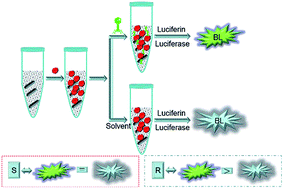Antimicrobial susceptibility testing by using virulent phages to evaluate bacterial viability†
Abstract
One of the most efficient approaches for minimizing antimicrobial resistance of pathogenic bacteria is to develop rapid and reliable diagnostic protocols for antimicrobial susceptibility testing (AST). Here a multidrug resistant Pseudomonas aeruginosa (P. aeruginosa) strain was used to isolate its virulent phages. Then the virulent phages were adopted to establish a bioluminescent (BL) method for evaluating bacterial viability. Since the viability of susceptible bacteria could be inhibited or eliminated by antibiotics, an AST protocol was designed by utilizing virulent phages to evaluate the viability of antibiotics-exposed bacteria. Minimum bactericidal concentrations (MBCs) could be easily obtained through comparing the BL signals of antibiotics-exposed bacteria in the presence and absence of phages. Within 3 h, the MBCs of tobramycin, gentamicin, ceftazidime, piperacillin and levofloxacin were evaluated to be <4 μg mL−1, 8 μg mL−1, >32 μg mL−1, >128 μg mL−1 and >8 μg mL−1, respectively. The protocol has immense potential to reduce the frequency of empirical antibiotic therapy. It can be extended to the AST of other pathogens by isolation of their virulent phages.



 Please wait while we load your content...
Please wait while we load your content...